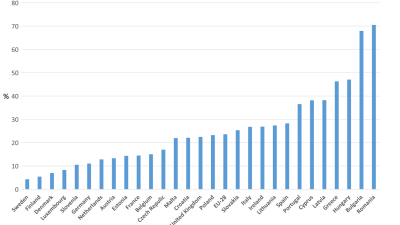Soaring energy bills are forcing families to spend more than ever on heating and maintaining their homes, according to official figures on the growing squeeze on household budgets – with those on lower incomes now spending 25 per cent of their income on housing.
The figures emerge from the latest annual Office for National Statistics report on household spending.
Key findings
- Households spent £489 a week on average in 2012, down over seven per cent (after inflation) since 2006, when households spent £526.40. This is consistent with trends in the economy during this period, with GDP falling by 7.2 per cent between 2008 and 2009 and with little or no subsequent recovery.
- The highest weekly spend in 2012 was on housing costs (rent, fuel, electricity and maintenance – but excluding mortgages). At £68.00, this for the first time overtook transport spending.
- The rise in housing costs is likely to have been driven in part by rises in electricity and gas prices, says the ONS. The cold winters of 2011 and 2012 also contributed to essential spending on heating. Another factor is rent payments: the proportion of households renting has increased in recent years, from 29 per cent to 34 per cent.
- Transport has seen the biggest spending reduction, falling from £87.10 a week in 2001-02 to £64.10 in 2012 (after inflation adjustment).
- The third highest spend is recreation and culture, at £61.50 a week (including spending on TVs, computers, newspapers, books and leisure activities, and package holidays abroad). Average weekly spending on food and non-alcoholic drinks in 2012 was £56.80. Spending on clothing and footwear increased from £15.30 a week in 2001-02 to £23.40 in 2012 (adjusted for inflation).
- The lowest-earning ten per cent of households spent an average of £189.30 a week in 2012, while the highest-earning ten per cent of households spent an average of £1,065.60.
- Lower-income households spend a higher proportion of their total expenditure on food and drink than higher-income households. The reverse trend is seen for transport. Spending on discretionary items such as clothing and footwear, and recreation and culture also increases sharply as household income rises.
- Those in the lowest income decile group spent 25 per cent of their income on housing in 2012, the highest of any except for the richest ten per cent.
Source: Family Spending: 2013 Edition, Office for National Statistics
Links: Report | ONS press release | BBC report | Guardian report



 PSE:UK is a major collaboration between the University of Bristol, Heriot-Watt University, The Open University, Queen's University Belfast, University of Glasgow and the University of York working with the National Centre for Social Research and the Northern Ireland Statistics and Research Agency. ESRC Grant RES-060-25-0052.
PSE:UK is a major collaboration between the University of Bristol, Heriot-Watt University, The Open University, Queen's University Belfast, University of Glasgow and the University of York working with the National Centre for Social Research and the Northern Ireland Statistics and Research Agency. ESRC Grant RES-060-25-0052.






